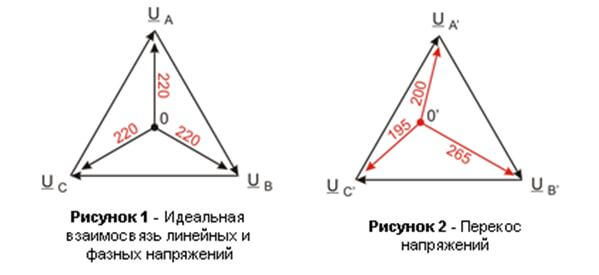What is the danger of phase imbalance in a three-phase network and when does it occur?
Valid Values
There are norms and permissible values that are indicated in the relevant GOSTs and PUE regarding the quality of electricity. According to these standards, the ratio between the currents of the least loaded conductors and the most loaded, in switchboards should not exceed the value of 30%, and in the switchgear panels - 15%. According to GOST p. 5.5, the permissible phase imbalance in the reverse sequence should be 2%, and in zero - 4%.
The causes of the phenomenon
There are several reasons for this action to occur. The main reason when a skew occurs is considered incorrect and uneven load distribution in the internal electrical network when one phase receives an overload. The second and third as a result will work with a significant underload.
In a network where only one phase is present, the load can also increase. This occurs when a large number of household appliances are included in the power. Then the skew becomes noticeable, as the power drops and the devices stop working.
Due to the fact that household appliances begin to work incorrectly, this can lead to their breakdown. As a rule, engines are considered the weak point in most devices in this case. Therefore, it is they who fail. Check where there is skew, you can use a special device (clamp meter), which will help determine which chain exists overload.
The three-phase network has a grounded neutral. It is she who equalizes the uneven distribution of voltage in the electrical circuit. But with zero break, one phase takes on the role of neutral. Then the voltage on it can reach up to 380 volts, and on the rest it will be 127 volts and lower.
Danger and consequences of skewing
What is the danger of phase imbalance in the power grid? Conditionally negative moments can be divided into three groups:
- Harm to electrical receivers (devices, equipment): damage to them, reduction of their useful life.
- Harm to sources of electricity: mechanical damage, increased energy consumption, reduced life of the source.
- Consequences for consumers: increased costs for electricity, the need for repair of electrical equipment, possible injury.
Due to the fact that the electricity is distributed unevenly across the conductors, electricity consumption increases significantly in the electricity network. A three-phase network, in which asymmetry has formed, can reduce the life of electrical appliances and household appliances.
If it is an autonomous power plant, then the oil and fuel consumption in this situation increases significantly, and the generator may break. In the case when one phase receives more voltage than the other two, electrical safety is violated. And this can lead to various electrical injuries, as well as to the ignition of electrical household appliances and the wiring itself.
As you can see, the consequences of this phenomenon are significant and their solution and elimination can lead to large material costs. In order to avoid such an unpleasant situation, certain measures should be taken in advance.
Protective measures
In order for the three-phase network to work symmetrically and the voltage on each circuit is normal, special devices should be used. Most often performed installation of a voltage stabilizer. In everyday life, single-phase devices are used that are able to protect electrical appliances and equipment. And in industry, a three-phase stabilizer is used, which consists of three single-phase devices. But such protective devices cannot completely eliminate the bias, since only one phase is fixed to them and they equalize the voltage only in it.
Therefore, a three-phase network cannot fully protect itself from such a phenomenon by stabilizers, and also eliminate their cause and consequences. There are times when these devices themselves are the cause of the uneven and improper distribution of energy. This problem can be fixed thanks to alternative technology, which is able to equalize the voltage at all phases of the circuit.
A three-phase network is protected from asymmetry in the following ways:
- the correct design of power supply, taking into account possible loads;
- the use of devices that are able to automatically balance the load;
- a change in the existing circuit of the energy consumption scheme (in the case when each phase was not previously calculated for overload);
- in the most critical situations it is necessary to change the capacity of consumers.
- installation of special phase control relay and voltage, which turns off the power if it detects an asymmetry (in the photo below).
In this way, bias in a three-phase power network can be eliminated and protect your electrical devices from breakage. Finally, we recommend watching a useful video on the topic:
So we examined the danger of phase imbalance in a three-phase network and how to protect yourself from this phenomenon at home. We hope the information provided was useful and interesting for you!
It will be useful to read:











